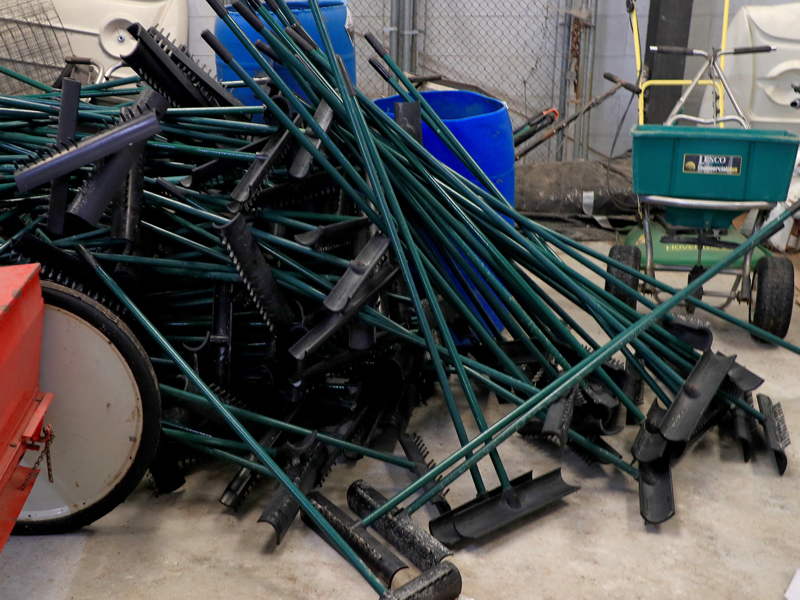Should We Get Rid Of Bunker Rakes For Good?
Could it have a positive effect on the way golf is played?


Fergus Bisset and Jeremy Ellwood debate whether removing rakes from bunkers permanently could result in positive changes in the way golf is played.
Should We Get Rid Of Bunker Rakes For Good?
Yes Says Fergus Bisset
Something positive about the return to golf after lockdown was the necessary simplifying of the game: A step back in time to a more streamlined, faster-flowing form of the sport many found hugely refreshing.
One element of this was the removal of rakes from the bunkers.
Not only did it save time, but it also changed playing dynamics for the better.
Bunkers should be hazards to be avoided.
Get the Golf Monthly Newsletter
Subscribe to the Golf Monthly newsletter to stay up to date with all the latest tour news, equipment news, reviews, head-to-heads and buyer’s guides from our team of experienced experts.
When Tiger Woods won his first Open Championship at St Andrews in 2000, he went 72 holes without finding one of the Old Course’s multiple, punishing traps.
The accuracy and careful strategy required to achieve the feat was remarkable; a key to his dominant victory.
But on most modern courses, bunkers aren’t enough of a threat to significantly alter strategy.
A flat fairway bunker can be played from, manicured greenside bunkers are no issue for most reasonably competent amateurs.
For professionals, they’re preferable to grass.
Thus, the modern golfer plays aggressively without considering the sand – It’s not a significant problem.
How different and more interesting would the game be if bunkers were actually proper, unpredictable hazards, as they are without rakes?
If finding a fairway bunker would, more often than not, result in at least one extra shot, almost all would be sure to lay up short of potential trouble, even at elite level, causing a desirable reduction of emphasis on the bombed drive, an increase on the accurate one.
If greenside bunkers presented a significant risk, players might be more wary of attempting the par-5 in two or of attacking the tough flag.
It would bolster the tactical and technical challenge in golf which has been diminished by modern technologies.
I say remove the rakes, make bunkers proper hazards again and put greater onus on the strategic side of golf.
Should We Get Rid Of Bunker Rakes For Good?
No says Jeremy Ellwood
Among the many things doing the rounds on social media following the resumption of golf in our brave new post-lockdown world was the suggestion in some quarters that bunker rakes, which had been removed for virus-related reasons, should stay permanently removed.
The notion was that we should all re-acquaint ourselves with the delights of playing from whatever sandy landscape previous golfers had left for us as golfers of yesteryear had to, and potentially speed up play in the process.
I’m all for simplifying a game that has, in many ways, become too much of a precisely controlled science rather than a pleasurable pastime.
But this would be, quite literally, a backward step too far in a world that occasionally looks back on history with rose-tinted spectacles when it comes to how good the good old days really were.
This, for me, is a misguided ‘wasn’t the past great’ argument that would quickly be abandoned the moment its supporters found their ball nestling at the bottom of a vast footprint in an overfilled bunker.
Chances are, they’d either still be there four shots later or reluctantly taking a penalty drop, which could well end up plugged even from knee height.
I’m pretty sure I’ve never played with anyone who, on arriving at a bunker to find their ball in the unraked footprint of a previous customer, has expressed sheer delight at this opportunity to broaden their game’s creative repertoire.
More like a string of expletives unprintable within these pages!
Heaven knows most golfers have enough trouble from perfectly raked bunkers, so any potential time-saving from just walking off and leaving them would be more than countered by the additional time spent swishing around in the sand.
For more golf news do not forget to follow Golf Monthly on Facebook, Twitter and Instagram.

Fergus is Golf Monthly's resident expert on the history of the game and has written extensively on that subject. He has also worked with Golf Monthly to produce a podcast series. Called 18 Majors: The Golf History Show it offers new and in-depth perspectives on some of the most important moments in golf's long history. You can find all the details about it here.
He is a golf obsessive and 1-handicapper. Growing up in the North East of Scotland, golf runs through his veins and his passion for the sport was bolstered during his time at St Andrews university studying history. He went on to earn a post graduate diploma from the London School of Journalism. Fergus has worked for Golf Monthly since 2004 and has written two books on the game; "Great Golf Debates" together with Jezz Ellwood of Golf Monthly and the history section of "The Ultimate Golf Book" together with Neil Tappin , also of Golf Monthly.
Fergus once shanked a ball from just over Granny Clark's Wynd on the 18th of the Old Course that struck the St Andrews Golf Club and rebounded into the Valley of Sin, from where he saved par. Who says there's no golfing god?
-
 JM Eagle LA Championship Prize Money Payout 2025
JM Eagle LA Championship Prize Money Payout 2025The LPGA Tour heads to California for the JM Eagle LA Championship, where the largest prize money payout of the season so far is on the table
By Mike Hall
-
 Corales Puntacana Championship Prize Money Payout 2025
Corales Puntacana Championship Prize Money Payout 2025The PGA Tour’s latest opposite field event features an attractive prize money payout and some former champions in the field
By Mike Hall